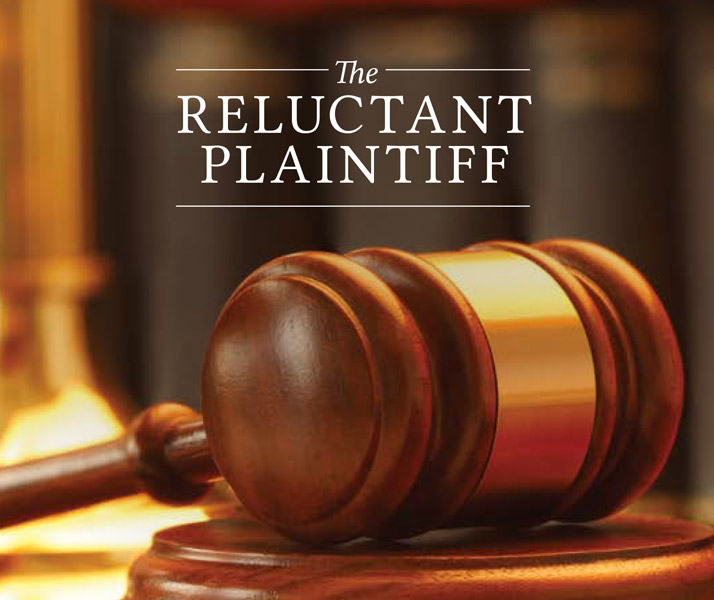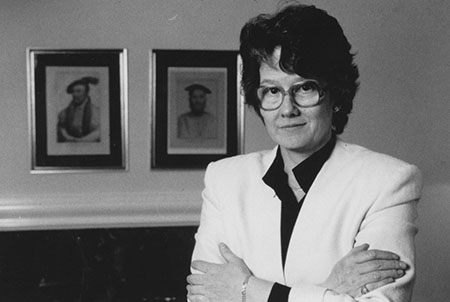
The Reluctant Plaintiff
Ann Branigar Hopkins ’65 gave her name to a landmark sex discrimination case decided by the U.S. Supreme Court.
By Mary Welek Atwell
In the 1989 ruling Price Waterhouse v. Hopkins, the court determined that gender stereotyping constituted a form of discrimination on the basis of sex prohibited by Title VII of the Civil Rights Act of 1964. Scholars have found Ann Hopkins’ legal action one of the most “generative” cases in discrimination law. It is a case that has led to many subsequent decisions expanding the reach of protection for women, minorities, and gay, lesbian, and transgender persons in the workplace. Among other things, Price Waterhouse v. Hopkins opened the door to the use of social science research in the interpretation of antidiscrimination law. Many women who have encountered the glass ceiling in their careers have cited the Hopkins lawsuit as precedent, as have others who experienced harassment at work based on their sexual orientation. The decision also set the standard of proof for employers who claim they did not discriminate in hiring or promotion. Hopkins was a reluctant plaintiff in the development of discrimination law. She told The Washington Post, “I had no choice but to sue. I had to do it as a matter of principle. It was inevitable and predictable. I did not set out to be a leader.”
 Ann Hopkins earned a B.A. in mathematics at Hollins. She wrote positively about her experience at a single-sex college, noting that the most interesting women she knew had attended women’s colleges. There they learned to depend on themselves and to rely on “analytical integrity” in addressing problems, rather than depending on or deferring to men. Her career exemplified the independence she described. After graduation Hopkins went on to get a master’s degree at Indiana University. She was invited back to Hollins the following year to fill in as an instructor for her mentor, Professor of Mathematics Claude Thompson, who was on sabbatical. She next took a position at IBM and worked in technical areas at several other large corporations before being hired by the accounting firm Touche Ross, where she was a project manager for their expanding computer systems. While at Touche Ross, Hopkins met fellow motorcycle enthusiast and her future husband, Tom Gallagher. Neither apparently worried about the effect of their marriage on their professional lives, until a few years later when Hopkins and Gallagher ran up against Touche Ross’ anti-nepotism policy. If both spouses were employed at the company, neither could be considered for partner. Hopkins decided to leave and in 1978 she took a job in the Office of Government Services at Price Waterhouse, another of the Big Eight accounting firms. Gallagher remained at Touche Ross and became a partner there. However, the complications of being married to a fellow professional followed Hopkins to Price Waterhouse, where she was informed that she was ineligible for partnership as long as her husband was a partner in a competing firm. In 1982, Gallagher left Touche Ross to form his own consulting business. That year Ann Hopkins was nominated to become a partner at Price Waterhouse, and her legal odyssey began.
Ann Hopkins earned a B.A. in mathematics at Hollins. She wrote positively about her experience at a single-sex college, noting that the most interesting women she knew had attended women’s colleges. There they learned to depend on themselves and to rely on “analytical integrity” in addressing problems, rather than depending on or deferring to men. Her career exemplified the independence she described. After graduation Hopkins went on to get a master’s degree at Indiana University. She was invited back to Hollins the following year to fill in as an instructor for her mentor, Professor of Mathematics Claude Thompson, who was on sabbatical. She next took a position at IBM and worked in technical areas at several other large corporations before being hired by the accounting firm Touche Ross, where she was a project manager for their expanding computer systems. While at Touche Ross, Hopkins met fellow motorcycle enthusiast and her future husband, Tom Gallagher. Neither apparently worried about the effect of their marriage on their professional lives, until a few years later when Hopkins and Gallagher ran up against Touche Ross’ anti-nepotism policy. If both spouses were employed at the company, neither could be considered for partner. Hopkins decided to leave and in 1978 she took a job in the Office of Government Services at Price Waterhouse, another of the Big Eight accounting firms. Gallagher remained at Touche Ross and became a partner there. However, the complications of being married to a fellow professional followed Hopkins to Price Waterhouse, where she was informed that she was ineligible for partnership as long as her husband was a partner in a competing firm. In 1982, Gallagher left Touche Ross to form his own consulting business. That year Ann Hopkins was nominated to become a partner at Price Waterhouse, and her legal odyssey began.
Despite her Hollins education, her decision to maintain her family name after marriage, and her strong commitment to having both a career and family, Hopkins seemed surprisingly unaware of the feminist movement or the larger patterns of discrimination. She experienced a number of professional issues unique to women, yet she apparently viewed these as personal, individual problems rather than examples of structural biases that disadvantaged women as a group. That changed as she navigated the path to partnership.
At Price Waterhouse, the process for electing partners was “collegial.” The existing partners were asked to vote and provide written comments about the nominees they knew. There were no particular guidelines and no limit on the number of candidates who could be approved. Hopkins seemed to be a strong nominee. An accomplished manager and a successful rainmaker, she had landed Price Waterhouse’s biggest ever consulting deal, a multimillion dollar contract with the U.S. Department of State. That year, along with Hopkins, 87 men and no other women were nominated for partnerships. None of the men had her track record for bringing in high-value clients. And yet, when the votes were counted, 13 partners supported Hopkins, eight voted against her, three wanted to hold her nomination for another year, and eight had insufficient information to cast a ballot. Sixty-two men were promoted, while Hopkins was told she could reapply in 1984. However, when she learned that it was very unlikely she would ever earn a partnership, Hopkins left Price Waterhouse, set up her own consulting firm, and filed suit for sex discrimination with the Equal Employment Opportunity Commission (EEOC).
Hopkins provided written comments made by the partners as evidence that her promotion had been tainted by prejudice against her as a woman. The negative responses to her candidacy focused on her “interpersonal skills.” She was criticized for being aggressive, for being difficult, for being impatient with staff. Others noted that she used profanity, that she was “macho.” One proposed that she should take a course in “charm school.” The advice quoted most often, even by the Supreme Court, came from a supporter, the partner in charge of her office. He suggested that to win over the senior partners Hopkins should “walk more femininely, talk more femininely, wear makeup, have her hair styled, and wear jewelry.” It seems revealing that an ally recognized implicitly that Hopkins’ difficulties with the partners stemmed, not from her performance at work, but from her failure to conform to their vision of how a woman should look and behave.
The case was first heard in the District Court in Washington, D.C. It was fortuitous that Hopkins sued Price Waterhouse at that time and in that court. Earlier in 1984, the Supreme Court had handed down a decision that impacted her legal situation. In Hishon v. King and Spalding, the court had ruled for the first time that partnerships, like other businesses and corporations, were covered by the Civil Rights Act of 1964 and were prohibited from discriminating on the basis of race, sex, or national origin. The ruling in Hishon meant that partnerships, including Price Waterhouse, could no longer claim to be voluntary associations who could choose their own members. They would be required by law to demonstrate that their promotion decisions were made without prejudice. It was also fortunate that the Hopkins case was argued before Judge Gerhard Gesell, a judge with a strong civil rights record. In addition, he was the son of noted child psychologist Arnold Gesell—a connection that may well have influenced how the judge responded to psychological testimony that was a key part of Hopkins’ argument.
In Judge Gesell’s court, her attorneys made the same points they would repeat throughout the litigation. They noted that out of 662 partners in the entire Price Waterhouse organization, only seven were women and two of them had been admitted since Hopkins filed her complaint with the EEOC. They argued that the partnership process at Price Waterhouse was subjective, that there were no clear standards for recommending partners, that Ann Hopkins’ “interpersonal skills” were evaluated by standards seldom applied to men. If Hopkins did not conform to feminine stereotypes, if, as one partner claimed, she “walked with authority,” that criticism had nothing to do with her qualifications and everything to do with her sex. Furthermore, Price Waterhouse had no policy prohibiting sex discrimination in partnership decisions, leaving the process open to the sort of “highly suspect” criteria that other courts had found unacceptable. Hopkins testified that she had been told to stop smoking, to quit drinking beer at lunch, and not to carry a briefcase, but to carry a handbag instead. Other witnesses described her strengths, her success with clients, and her significant role in attracting business to the firm.
Probably the most significant testimony in support of Ann Hopkins came from psychologist Susan Fiske, who made the point that sexual stereotypes played a major determining role in denying the partnership. In an organization like Price Waterhouse, where women were a tiny minority among the partners, “tokens” in Fiske’s term, attention to their gender would be unavoidable. In analyzing the comments about Hopkins, Fiske found examples of categorical thinking—the view that “men do x” and “women do y.” She testified that many people have gendered expectations and they tend to see things that confirm those expectations. As she described stereotyping, it created a “double bind” for professional women who faced a conflict between socially approved notions of femininity and professional standards of competence. They were expected to display masculine qualities to be successful, yet if they did so, they would be judged as “the wrong kind of woman.” The loose, “standardless” partnership process at Price Waterhouse meant that women could be scrutinized more closely on the “feminine dimensions” of their performance, such as interpersonal skills, factors that could not be measured like earnings or contracts negotiated. In Fiske’s view, Price Waterhouse made no effort to diminish stereotyping. Until Hopkins took them to court, they even tolerated the comments of one senior partner that he “could not consider any woman seriously as a partnership candidate and believed that women were not even capable of functioning as senior managers.”
Price Waterhouse defended their process and their decision about Ann Hopkins, claiming that they judged potential partners only on the basis of standards, criteria that were applied without regard to sex, race, or religion. As for Hopkins, it was her lack of interpersonal skills, her pervasive weakness. Even had she been a man, they asserted, she would have been denied promotion.
Judge Gesell found that Hopkins had been the victim of discrimination, but he refused to require that Price Waterhouse make her a partner and award her back pay. He ruled that the firm had acted on both permissible factors (poor interpersonal skills) and impermissible factors (sex discrimination). Once Hopkins had shown that bias had played a part in the decision, the burden shifted to the employer to prove that they would have reached the same decision without the discrimination. The ruling was historical for defining sexual stereotyping as a form of discrimination. When Price Waterhouse appealed the decision to the D.C. Circuit Court of Appeals and to the Supreme Court, both not only agreed that Hopkins had suffered discrimination, they also ordered Price Waterhouse to make her a partner.
It is the rulings of the U.S. Supreme Court that go beyond the individual case and that must be applied in every jurisdiction. Thus when Justice William Brennan wrote the decision in Price Waterhouse v. Hopkins, it was a legal and historic landmark. A major consequence of the ruling was the definition of a “mixed motive” framework to interpret claims of discrimination. If an employee can show that sex (or race, age, religion, or national origin) was one of the motives in an unfavorable decision, the burden of proof shifts to the employer, who must show that sex was not the controlling motive. The employer must prove that the decision would have been the same had sex not been a factor. Perhaps equally significant was the Supreme Court’s acceptance of sex stereotyping as a form of discrimination. Justice Brennan wrote, “We do not sit to determine whether Ms. Hopkins is nice, but to decide whether partners reacted negatively to her personality because she was a woman.”
 The court’s decision was not without its critics. Three of the more conservative justices—Kennedy, Rehnquist, and Scalia—joined a dissent that supported Price Waterhouse’s position. They found that employers had no responsibility to “disclaim reliance on sex stereotypes,” no duty to sensitize their employees about bias, and no duty to “root out sexist thoughts.” But the majority of the court was not demanding an end to sexist thoughts, only that they not control decisions about employment and promotion.
The court’s decision was not without its critics. Three of the more conservative justices—Kennedy, Rehnquist, and Scalia—joined a dissent that supported Price Waterhouse’s position. They found that employers had no responsibility to “disclaim reliance on sex stereotypes,” no duty to sensitize their employees about bias, and no duty to “root out sexist thoughts.” But the majority of the court was not demanding an end to sexist thoughts, only that they not control decisions about employment and promotion.
The case returned to the District Court and Judge Gesell to decide an appropriate remedy, once Price Waterhouse had been found liable for discrimination. Despite misgivings that led him to ask Hopkins if she really wanted to work at a firm that did not seem to want her, Gesell ordered that Ann Hopkins be made a partner and that she be awarded back pay of about $371,000 as well as legal costs. In February 1991, almost nine years after the initial vote against her, she returned to Price Waterhouse as a partner.
At first, Hopkins was assigned to a quiet office in Bethesda, Maryland, where there were few colleagues and little activity. Although she was often invited to make speeches and to appear at events to discuss her case, Hopkins felt she had “nothing to do.” She decided to write a book about her life and experience, So Ordered: Making Partner the Hard Way. Eventually, Hopkins returned to her old area of expertise, the Office of Government Services, and, in her own words, she “became an outspoken advocate for a culture that prized diversity and sought and nurtured it in the workplace.” She retired from Price Waterhouse in 2002.
Ann Hopkins was onto something when she mentioned workplace culture that prized and nurtured diversity. Supreme Court decisions resolve disputes over the meaning of laws or the Constitution. Beyond such rulings, actual changes that would significantly restructure power relationships are often slow in coming. Hopkins, a reluctant litigant, deserves to be remembered by the many women and men who benefited from her case. But despite progress, the glass ceiling has not yet been dismantled nor has stereotyping disappeared from the decision-making process in business, academia, or public life.
Mary Welek Atwell retired after 40+ years of teaching at Hollins and Radford University. She is the author of four books on the topics of gender, law, and criminal justice. She is currently working on a book on sexual harassment.
Ann Hopkins died at her home in Washington, D.C., on June 23, 2018, of acute peripheral sensory neuropathy. The Hollins Digital Commons contains a gallery for finding guides to a collection of papers related to the Price Waterhouse v. Hopkins Supreme Court case. It includes numerous newspaper and periodical articles that document Hopkins’ journey from beginning to end, court transcripts, personal and professional correspondence, materials related to her 1996 memoir, a scrapbook album, and other papers. For more information, contact Beth Harris at bharris@hollins.edu.
A Note on Sources
Quotations from Ann Hopkins came from her memoir, So Ordered: Making Partner the Hard Way, from interviews with The Washington Post and The New York Times, and from “Price Waterhouse v. Hopkins: A Personal Account of a Sexual Discrimination Plaintiff,” Hofstra Labor and Employment Law Journal (22:2) 2005.
